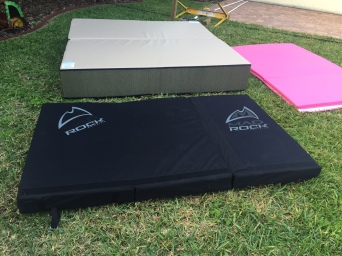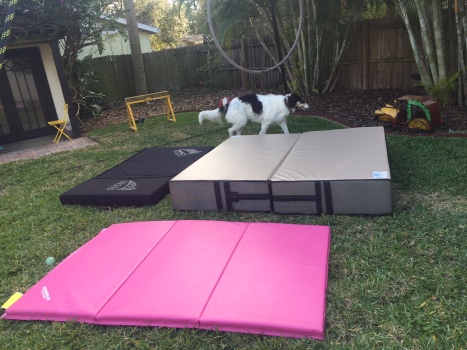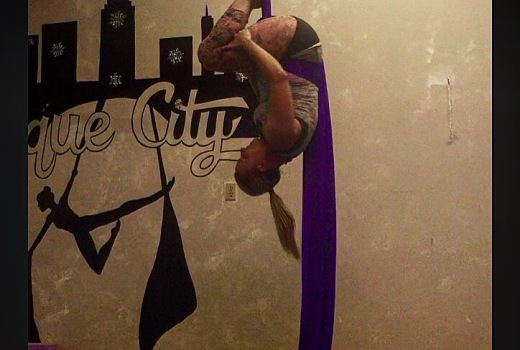II’ve had my Lyra for over 8 months. I’ve brought it into studios and used it on my outdoor rig. I still love it! Most of the time it is stored inside in my dance room which is air conditioned yet about 2 months ago it started to rust through the tape. I live in Florida where the humidity is very high. It is possible that I set my hoop down in wet grass or something. I’m not exactly sure why it is rusting. I’ve been busy but it has reached the point that it is time to clean off the rust on my hoop and re-tape. Basically, make it pretty again.
These are the “before” pictures as I was taking off the tape. It was really pretty disgusting.
I needed to start my research again to figure out the best way to do this…
I opened Facebook on my laptop and went to the Safety in Aerial Group. I knew I had read about ways to clean and re-tape your hoop in some of the posts. I plugged “rust” into the search bar and started reading.
This is what I found:
Yes, other people have this problem. Probably, the best way to solve it is to have it powder-coated (or to have bought a stainless steel or aluminum hoop to begin with…). Well, I’m not ready to make the powder-coating leap yet. So I’m going to start by cleaning it.
Suggestions for cleaning it:
- Use steel wool to clean the rust off (Grade #0 Fine did not work)
- Use 200 grit sand paper to clean the rust off (When I spoke to one of my aerial instructors this is what she has done in the past. This is also what worked the best for me.)
- Use 3M Scotch-Brite General Purpose Hand Pad to clean the rust off (This helped get the dirt grime off but didn’t really see it get rust off.)
- Use Navel Jelly to dissolve the really stubborn rust off (You can buy it at Home Depot. Use gloves & do it outside. I did not actually need to use it but its good to know & have on hand.)

Cleaning supplies
Keep it from rusting:
After cleaning it there were several suggestions on how to keep it from rusting again.
- Powder-coating (I’ll look into this in the future but right now I’m trying some other things)
- Oiling/lubricating (It would probably work but I’m having a mental block about putting oil onto an apparatus that I’m going to be hanging from…):
- Sentry Solutions Marine TUF-CLOTH to stop the rust
- T-9 Boshield to protect the metal from rust. This was copied from the Boshield website “T-9 dries to a waxy, waterproof finish without leaving a sticky film.” (you can buy it at any woodworking store)
- FYI: W-D 40 does not protect from rust.
- Spray painting (use Rust-Oleum or Kyrlon Hammer Finish)
- Taping and putting a coat of acrylic paint over it
I decided to try to clean it the best I could. Use Rust-Oleum to paint it. Then re-tape it. I read that several studio owners do this but they need to re-do it about twice a year. I will try and and report how it does in future posts.
My process
Cleaning the hoop
- I took all the tape off
- Then I started cleaning. I took it outside and started with the steel wool.

Steel Wool.
I went through 2 pads before I realized it wasn’t really doing anything. I was using the “Grade 0: Fine” steel wool. Maybe this wasn’t tough enough.
- The steel wool was actually sticking to the left over adhesive. So I went and found some GOO GONE and a rag and started wiping the adhesive off. That really helped.

GOO GONE!
- That’s when I noticed that the cement pavers on my patio were scratching my metal hoop so I found an old towel to put down to protect it.
- Not to worry because I switched to the 220 grit sand paper and that really started to clean it up. The sand paper cleaned off the rust and a lot of the black dirt. It also filed down any of the scratches that were rough. My hoop started getting shiny.

Protect the hoop from scratching on concrete.
This was extremely dirty and my hands, arms, face, shirt all started turning black. LOL. It was so messy & I was outside in 90 degree heat so it was everywhere.

So dirty!

Result of my cleaning supplies.
- Then I found a Scotch-Brite sponge scrub pad and some dish soap to wash it. I took a garden hose and soaped it up.

Dawn and Scotch-Brite Scrub Pad.
Initially, I was just going to use the sponge but once I started washing it a lot more of the black, dirty grime started coming off. I switched to the green scrub side and this REALLY helped clean the hoop up. Now it was shiny!
- I dried it off with a towel and set in out in the sun to dry.

Its all clean and shiny!

Look at the shine. No more rust.
What I would do differently
If I were to do this again (and I’m not sure how it will work now that I’ve spray painted the hoop)…
- After removing the tape, I’d wash it first with the sponge and soap
- Use the GOO GONE right away
- Then maybe take the Scotch-Brite scrub to it
- If there is still grime and rust then I’d use the sand paper
- And finally if needed I’d use use the Navel Jelly.
Spray painting the Lyra
This was easy. I saved this screen shot from Steve Santos with the idea of following it to a T.

Screen Shot from a Facebook’s Safety in Aerial discussion about rust on hoops.
I went to Home Depot to buy supplies and called my Fiance to see if we had a “torch.” We do but he told me I didn’t need to use it (I think he didn’t want me burning down the house.). That all I needed to do was leave the hoop in the Florida sun to heat up and dry off all the moisture. I understand that there is still a ton of moisture in the air and I probably should have heated the hoop up but I’m learning to pick & choose my battles with my Honey Bunny and this was one I didn’t want to fight so I let it go. My hoop did get very hot in the sun so hopefully it worked **Fingers crossed**
- Bought Rust-Oleum Primer and Spray Paint. The color isn’t going to matter but I really liked the light metallic champagne pink color.

Spray paint!
***LOOK at this sparkly glitter spray paint. OMG! I didn’t know if I’d actually use it but it was too cool not to buy. I was thinking about using it and not taping the hoop and maybe the glitter would act a bit more grippy. When I mentioned this to my Fiance he didn’t think the glitter paint would stay on very long and would scratch/peel off right away with use. Anyone have thoughts on this? I’m not brave enough to try it yet***
- I hung it on my rig outside by one spanset and started spraying the primer.

Hung it outside from one spanset.
I did a light coat about 6-12 inches away from the hoop. Let it dry for about an hour. then moved the spanset to the other side and did another light coat. Then I let it dry for 2 hours and brought it inside to dry overnight.

First coat of primer.
- Then the next day I did the same thing with the champagne pink spray paint. It actually started raining about an hour after I sprayed. Once it stopped I took it down and dried it off and set it inside to finish drying.

Metallic Champagne Pink Spray Paint. I LOVE this color!

Its almost the same color as my wall.Taping my Lyra
Taping my Lyra
When I was first purchasing hardware for my Lyra I bought some Mueller’s Athletic tape knowing I’d eventually need to re-tape it. I found it on Amazon.

Mueller Tape 3 rolls, 1 1/2 inch x 10 yards

Comes in many colors!
This is what I found when searching for how to tape a Lyra (tape an aerial hoop). Its a lot like taping a hula hoop. These are some helpful tips:
- Tape from the bottom to the top. if you don’t do this then the tape will roll over on itself as your hands/body slides down the hoop.
- If you look at the hoop as a clock with 12 at the top. Start taping at 7 going up to the top towards 1. Then go the opposite direction starting at 5 and going up towards 11. This gives you some overlap at the bottom where there is most wear.
- Here is a video that shows a taping tutorial.
In all it took less than 20 minutes and I thought this was the easiest part of this entire process.
- I started the tape at 7 on a clock and wrapped around the hoop tube it so it overlapped itself 1/2 the width of the tape.

Starting the taping.
2. I tried to keep the tape tight against the hoop to keep any wrinkles out.

I started at about 7 on the clock.

This was one roll of 10 yards of tape.
3. Once I finished one roll of tape. I took a second roll and started at the 4/5 on a clock and started wrapping clockwise. This roll seemed to have more strings come off the tape. A few times I had to stop and turn my roll of tape over so the other side of the tape was being overlapped to keep it from unraveling. (I guess I’ll see how that works out.)

The second roll I started at 4/5 and wrapped clockwise.
4. Using the second roll of tape I was able to complete the hoop part and go all the way across the straight part and ended where the hoop starts to curve again. I had just a bit left on the roll.

Finished! OMG its like I have a new hoop!
5. The hoop is SO BEAUTIFUL. It looks like a brand new hoop! Why didn’t I do this sooner?

It matches all my other pink stuff.
Please let me know if you have any other suggestions or if you tape/protect your hoop in different ways.
Types of tape that people use to cover their Lyra:
- Mueller Athletic tape (M-Tape)
- Generic athletic tape / adhesive cotton tape (ie. Zonas Zinc Free tape)
- Newbaums handlebar tape (its soft & not sticky)
- Hockey tape
- Some people use foam pre-wrap or under wrap under the tape for padding or use several layers of cotton tape
- Gaffer tape (heavy cotton cloth with strong adhesion properties, typically used to tape down cables to the floor during stage productions, try the brand Polyken, tends to be expensive)
- Baseball/tennis racquet tape
- Soft side of velcro tape (??)
- ESI Silicone tape
Ways to decrease stickiness of a taped hoop:
- Put chalk on in
- Coat it with acrylic paint
- Instead of chalk dust a fresh tape job with shimmer powder
- Someone posted that “zinc” in the tape is what gives it the sticky goo so look for zinc free tape
UPDATE: 10/16/16 The Mueller Tape that I used is SUPER sticky! It really eats up my hands. I’ve just seen a recommendation for Meister Tape. I think it can be purchased off Amazon. I’ll probably try that next time.







































